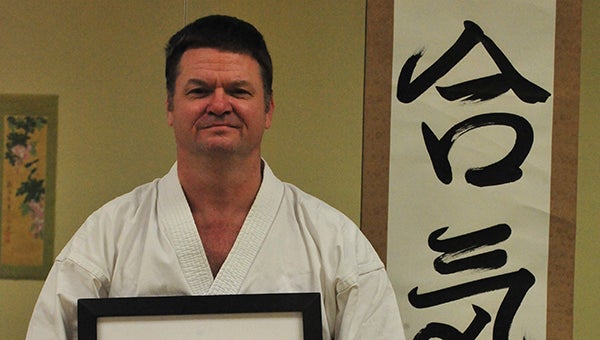Learn self-defense, find inner peace in Saluda Aikido studio
Published 10:00 pm Friday, August 5, 2016

Sensei Ken Gardner holding a photograph of Morihei Ueshiba, founder of Aikido. Behind Gardner is a slogan noting “Aikido– the Way of Harmony. (Photo by Mark Schmerling)
SALUDA – Sensei Ken Gardner described why he began studying martial arts, and why he now teaches Wadokai Aikido twice a week in Saluda.
“Just to be a better person,” he states calmly. “First, it was self-defense.”
Gardner teaches Mondays and Wednesdays at the Saluda Senior Center (lower level), with classes beginning at 6 p.m. All are welcome; the cost is modest.
Trending
Though Aikido can protect practitioners against the most violent of attacks, most of what Gardner teaches and promotes is both calm and calming. Rather than promising fast results, Aikido “is a life development,” Gardner noted.
“I started studying when I was 19, but not this style—kind of judo style,” he explained.
Gardner has been teaching for nearly ten years. Around 2005, Gardner began studying under the famed Aikido authority Sensei Roy Suenaka. In the early 1900s, Morihei Ueshiba (known as O Sensei) developed Aikido and wrote “The Art of Peace.” From the older type of Aikido, Suenaka, who refers to himself simply as “sensei,” developed Wadokai.
In martial arts, “sensei” means teacher. It’s a term of respect and acknowledgement of the skills and knowledge one has developed.
Aikido, like some other martial arts, helps the student gain self-confidence and calm, and helps the student understand how not to escalate a situation, without becoming involved in a physical altercation.
Aikido uses an attacker’s energy to stop the attacker.
Trending
Cassandra Nelson, who has studied under Gardner for over three years, notes of the spiritual aspect of Aikido, “If you don’t go within, you go without.”
“If you have to fight, you’ve already lost,” Gardner emphasized.
Greeting students in Gardner’s studio, and printed in Japanese is a sign noting simply “Aikido—the Way of Harmony.”
Aikido is composed of three words: ai (meaning harmony), ki (spirit or energy) and do, (the path). Unlike in many other forms of martial arts, Aikido practitioners try to defend themselves without harming their attackers.
Most attacks are linear. Aikido movements are generally circular, aiding in the re-direction of the attacker’s energy. Even in self-defense, Aikido practitioners find and employ harmony and calm.
In some ways, the practice of Aikido might be similar to the expression about making lemonade from lemons.
“Sensei Suenaka cares about everybody,” Gardner said. “You can be a really good person, and still be an effective martial artist.” Gardner describes Suenaka, now in his mid-70s, as “such a unique individual,” and “so approachable.”
Describing the many experiences he’d had in Aikido, and the variety of people the discipline has brought into his world (and vice versa), Gardner notes, It’s a positive experience. You get to meet different people in different parts of their lives. Everything relates back to Aikido. Everything moves into the development of you.”
“It’s a little bit of soft, a little bit of hard,” Gardner said in describing many of the movements. Like most other forms of martial arts, Aikido has basic requirements for each advancement level. Gardner noted that in Aikido, the dojo (the teaching and practicing studio) “becomes sort of like a temple, a place of self-development. Who you have in class, and who you associate with is what makes it all worth it. Aikido’s motto is about not speaking ill of others, and about unifying mind and body.”
“Everyone is welcome,” Gardner stated.
Nelson added, “Anywhere you go, if you go to a dojo, you’ll know you’ll have a place to stay.”
One of the many benefits of studying with Gardner is being able to attend summer camps, and meeting Suenaka.
Wadokai Aikido has no tournaments. “You’re not fighting,” Gardner notes. “You’re flowing.”
In many ways, Gardner has found a home in Wadokai Aikido.
“By helping other people, you get better. I have to have other people with the same spirit . . . I cannot not do this in my life.”





